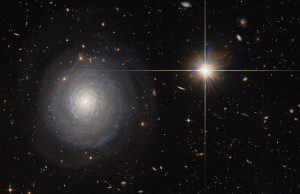
Each summer I do a series with my high school and college students called “Digging Deeper”. We cover theological topics such as the Trinity, creation and fall, salvation, and this year, faith and science. This is not a class or a study, it’s an opportunity to actually do theology with students. At the Progressive Youth Ministry Conference this past year in Dallas I had the opportunity to hear from people like Paul Wallace, Catherine Keller, and Tony Jones on the Science for Youth Ministry initiative. After the conference I decided that faith and science would be our summer topic.
As a guide for our discussions I have been reading the book Stars Beneath Us: Finding God in the Evolving Cosmos by Paul Wallace. I’ve used it as a tool to help guide us through questions, both scientific and theological, and as a narrative touch point for those in our group questioning the relationship between faith and science. From the outset I thought this would be a time of discussion and reflection upon how we understand the created natural world and the role God plays in it. However, our discussions took us not just into the world of faith and science, but beyond it toward questions of love and freedom. In the same vein as Rob Bell’s talk at PYM16, every question we asked gave us an answer, and every answer we had spurred on a question.
(On a side note, this is what is beautiful and wonderful about “doing” theology with students. They are capable of theological investigation, and will challenge and push one another to think critically and faithfully about God and the God/world relationship. They’re always willing to question normative beliefs and push past the status quo.)
In our first week we talked about creation as the place where for most Christians and non-Christians alike, the relationship between faith and science comes into question. Can we believe in a natural evolving world and also a loving God who created that world? If we live in a natural evolving world then why do we need God? Does faith or science take priority in answering the great question of where did we, and our universe, come from? We asked many of these same questions and had wonderful discussions.
The interesting thing is that even in more progressive circles the compatibility of faith and science is still in question. I had often thought the debate was over, that these were really questions that my generation and the generations before had dealt with. Students are influenced by the media and friends who have either more conservative or more progressive beliefs in regard to faith and science, but neither the church nor their educational institutions give them an outlet to discuss and process their ideas.
We dove right into the place Paul Wallace started his investigation, with Deep Time. We talked about the creation of the universe, the historical viability of the creation story, carbon dating. We talked about the two great extinctions, the complexity of human life and the length it took to fully develop nucleated cells. We began questioning God’s role in all of this: was there a literal Adam and Eve? Does God understand time in a different way than we do? Is it ok that the Bible isn’t historically and scientifically verifiable?
It became apparent after a while that the students were all on board with the compatibility of faith and science, even the ones who might have been a little timid about it at first. It all just made sense to them. In this relationship of faith and science the students saw beauty. They saw a complex world where earth was assembled 4.5 billion years ago, where it took 200 million years to form nucleated cells, and now it’s taken 4.5 billion years or so to form life as we know it today. They saw beauty in a God that created a natural world to actually work. God for our students isn’t the great scientist, God is the great creator, the great artist, who created science to work as just that—science!
This is where it got really interesting. We started with the assumption, for right or wrong, that humans are beings made in the image of God and, therefore, the pinnacle of creation. Now, these are the questions that followed: why did there need to be two massive extinctions, in which there was obviously deep animal suffering, to get to us? Why did God have to let the world essentially kill itself off, not just once, but twice?
This is where the questions of love and freedom arose. In God’s love does God necessitate creaturely or natural freedom? If you’ve read anything from Tom Oord this would be a similar position to take. God’s abundant love, which is an ontological component of God, is uncontrolling for love is never coercive. In many ways this is where the students ended up. God as creator, created an evolving cosmos to do just that evolve in the way nature would have it God created a world to be free in its natural state, freedom is a predicate of creation. Thus, the extinctions are part of the evolving world. However, while we may have access to the “hows” of the cosmos, we don’t always have total access to the “whys” of the cosmos. I didn’t teach the students to think in this manner, they didn’t read The Uncontrolling Love of God by Tom Oord. They simply had the opportunity to think through faith and science, their compatibility and viability as sciences in their own right. They were given space to be theologians.
I could write more about why I don’t actually agree with some of the positions they took, but part of our Digging Deeper series is that we don’t have to agree with each other, and that includes me as their leader. It’s ok for us all to disagree theologically, politically, socially, scientifically, etc., as long as we do it in a civil and loving way. Digging Deeper isn’t about taking positions it’s about theological reflection in the context of community.
















